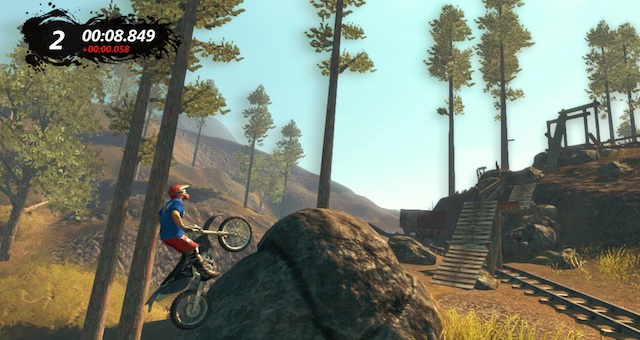At first blush, motorbike racing title Trials Evolution carries all the trappings of another dude-driven race title. Developed by Finnish studio RedLynx, the Trials series is essentially a puzzle game in which you throttle and weight-shift your way over, around, above, and beneath a wide variety of obstacles. It’s a demonstration of in-game physics as a type of physical exertion—the push-up regimen routine for the videogame set. This bravado is found everywhere in Evolution, from the cringe-inducing faux rap track in the opening sequence, the voicework from the Jackass crew, and the costume designs pulled from the Tapout school of tribal apparel. It’s as if RedLynx channeled Dr. Pepper Ten’s slogan “It’s Not for Women!” Just bikes and bros, man.
But somewhere in the middle of the fiery hoops, the explosive interludes, the backflips, the bailouts, the wheelies, the bunny hops, is a beatific moment of complete zen. It’s called Gigatrack, the last race found at the close of the Collateral Damage circuit.
For comparison, most tracks in the Trials games can be completed in roughly 45 seconds. My first stab at Gigatrack took more than 15 minutes as I rolled through hill after hill, rock after rock, one straightaway after another. Gigatrack is roughly a pastoral sequence with nothing innately difficult about it—no 140-degree inclines to scale, or jumps to master. It just requires patience.
In a well tuned game, skill acquisition and difficulty are areas of meticulous concern. Many designers pull from Hungarian psychologist Mihaly Czikszentmihalyi’s “Flow” theory, which dictates that player enjoyment lies in balancing challenge and skill. Too much challenge and not enough skill leads to anxiety; the converse creates boredom. So after leading players through exercises in speed bursts and high jumps, why did RedLynx throw this brick into our highly-tuned machinery?
There’s a secret agenda at work here. At its heart, Trials Evolution isn’t about speed or dexterity—it’s about reflection. It’s not about what’s directly in front of you, but what’s around you. In Gigatrack, your attention could be at the rock directly in front of you, but it’s more useful to think about the serenity just in the distance. Its moments are profound—the onset of twilight as you climb through the highest peak, the flicker of your headlamp after each trick, the hooting of owls against the putter of your engine, the yellowing sun set against a purple miasma over the mountain range. This is the heart of Trials.
But it’s not just about setting—the motorcyle itself is perfect for reflection, and filmmakers have tapped into that ethos better than most. The feeling of convergence with the road, the lack of barriers, the merging of man and machine—all of these have been thematically wed in films as wide-ranging as Walter Salles’ The Motorcycle Diaries and KS office favorite Dumb and Dumber.
Perhaps no film better captures the interplay of scenery and machinery than the jump sequence of 1963 John Sturges WWII escape epic, The Great Escape. We find Steve McQueen at the helm of a TT Special 650 Triumph, rolling through the countryside, scanning miles of barbed wire in a desperate hunt to find a possible opening. The scene is an iconic one—the furrowed brow of McQueen and an outfit that looks more at home on the J. Crew website than on a P.O.W. The bike roars over each hill in preparation before that final leap, and the rhythm of each dip of the landscape sets the manic nature of escape against the peaks in the Bavarian landscape.
What Sturges does so brilliantly is add weight and dimension to an otherwise anodyne stunt. It’s not just the gravity of jump—McQueen makes it or he dies—but the preparation, the buoyancy of the jump itself, and ultimately the setting that pulls that leap into coherence.
Trials does the same—the jumps in themselves are only part of the appeal. Flash title Line Rider, at its core, does the same. It’s the packaging that we find appealing. Without the energy and ambience of the background, we care not at all about the seemingly simple challenge of jumping over a rock.
But the twist, of course, is the surreality of what it is you’re doing. There are no Nazis to escape, no mission to complete, no further objective than just to hurtle yourself forward and breathe in the scenery. There’s nothing more than that. A friend of mine tweeted an image of himself playing a level in Trials, a particularly difficult patch with a vertical Stonehenge-like obstacle that he was attempting to surmount. He was trapped in space, nearly upright, nearly over the beast. But there was no indication if he would actually make it over and this was nearly his 200th try. The caption he gave was simple: “The meaning of life.”
That’s the moment I had at minute 15 of my run of Gigatrack. It was just me, my bike, and a big open road.
